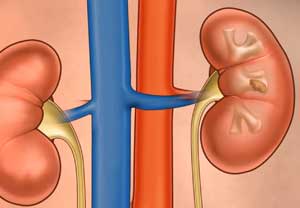Space researchers develop ultrasound technology that detects, treats kidney stones
HOUSTON – (Jan. 31, 2012) – Just the mention of kidney stones can cause a person to cringe. They are often painful and sometimes difficult to remove, and 10 percent of the population will suffer from them. In space, the risk of developing kidney stones is exacerbated due to environmental conditions. The health risk is compounded by the fact that resource limitations and distance from Earth could restrict treatment options.
Scientists with the National Space Biomedical Research Institute (NSBRI) are developing an ultrasound technology that could overcome some medical care challenges associated with kidney stone treatment. The new technology detects stones with advanced ultrasound imaging based on a process called “Twinkling Artifact” and provides treatment by “pushing” the stone with focused ultrasound. This technology could not only be beneficial for health care in space, but could also alter the treatment of kidney stones on Earth.
The project is led by NSBRI Smart Medical Systems and Technology Team Principal Investigator Dr. Lawrence Crum and Co-Investigator Dr. Michael Bailey; both are researchers at the Applied Physics Laboratory at the University of Washington (APL-UW). Bailey said their technology is based on equipment currently available.
“We have a diagnostic ultrasound machine that has enhanced capability to image kidney stones in the body,” said Bailey, a principal engineer at APL-UW. “We also have a capability that uses ultrasound waves coming right through the skin to push small stones or pieces of stones toward the exit of the kidney, so they will naturally pass, avoiding surgery.”
Currently on Earth, the preferred removal method is for patients to drink water to encourage the stones to pass naturally, but this does not always work, and surgery is often the only option. In space, the threat from kidney stones is greater due to the difficulty of keeping astronauts fully hydrated. Another factor is that bones demineralize in the reduced-gravity environment of space, dumping salts into the blood and eventually into the urine. The elevated concentration of salts in the urine is a risk factor for stones.
Crum, who is a principal physicist at APL-UW, said kidney stones could be a serious problem on a long-duration mission. “It is possible that if a human were in a space exploration environment and could not easily return to Earth, such as a mission to an asteroid or Mars, kidney stones could be a dangerous situation,” Crum said. “We want to prepare for this risk by having a readily available treatment, such as pushing the stone via ultrasound.”
Before a stone can be pushed, it needs to be located. Standard ultrasound machines have a black and white imaging mode called B-mode that creates a picture of the anatomy. They also have a Doppler mode that specifically displays blood flow and the motion of the blood within tissue in color. In Doppler mode a kidney stone can appear brightly colored and twinkling. The reason for this is unknown, but Crum and Bailey are working to understand what causes the Twinkling Artifact image.
“At the same time, we have gone beyond Twinkling Artifact and utilized what we know with some other knowledge about kidney stones to create specific modes for kidney stones,” Bailey said. “We present the stone in a way that looks like it is twinkling in an image in which the anatomy is black and white, with one brightly colored stone or multiple colored stones.”
Once the stones are located, the ultrasound machine operator can select a stone to target, and then, with a simple push of a button, send a focused ultrasound wave, about half a millimeter in width, to move the stone toward the kidney’s exit. The stone moves about one centimeter per second. In addition to being an option to surgery, the technology can be used to “clean up” after surgery.
“There are always residual fragments left behind after surgery,” Bailey said. “Fifty percent of those patients will be back within five years for treatment. We can help those fragments pass.”
The ultrasound technology being developed for NSBRI by Crum and Bailey is not limited to kidney stone detection and removal. The technology can also be used to stop internal bleeding and ablate (or destroy) tumors. Crum said the research group has innovative plans for the technology. “We envision a platform technology that has open architecture, is software-based and can use ultrasound for a variety of applications,” he said. “Not just for diagnosis, but also for therapy.”
NSBRI’s research portfolio includes other projects seeking to develop smart medical systems and technologies, such as new uses for ultrasound, that provide health care to astronauts in space. Crum, who served eight years as an NSBRI Team Leader, said the innovative approaches to overcome the restrictive environment of space can make an impact on Earth.
“Space has demanded medical care technology that is versatile, low-cost and has restricted size. All of these required specifications for use in a space environment are now almost demanded by the general public,” Crum said. “One of the reasons that translation from one site to another is possible is because of NSBRI’s investment.”
The ultrasound work by Crum and Bailey has also received support from the Defense Advance Research Projects Agency, the National Institutes of Health, and the University of Washington and foundations associated with it to promote commercialization.
NSBRI is a NASA-funded consortium of institutions studying the health risks related to long-duration spaceflight and developing the medical technologies needed for long missions. NSBRI is headquartered at Baylor College of Medicine in Houston, with its science, technology and education projects taking place at more than 60 institutions across the United States. In addition to protecting astronaut health, NSBRI research has benefits for health care on Earth. For more information about NSBRI, please visit www.nsbri.org.





